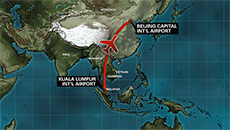John Kerry visits India Wednesday as a raft of crises consume American diplomacy. By contrast, US-India relations are at a moment of opportunity, but the US Secretary of State faces challenges in New Delhi that are significant in their own way.
For one thing, after a decade of disengagement with Narendra Modi, Washington is eager to make a fresh start. The US is sending three cabinet secretaries to India in quick succession - Kerry (State), Penny Pritzker (Commerce), and Chuck Hagel (Defence) - and Washington is preparing to host Modi himself in September. From the US perspective, Modi’s government offers a welcome respite from years of perceived strategic and economic drift under UPA-2.
But Kerry’s visit is also very well timed:
First, the NDA government has been in office for nearly two months. Modi has met Xi Jinping and Vladimir Putin, among others, so it is high time for cabinet-level US engagement.
Second, as Kerry himself argued in a speech this week, relations with strategically important countries cannot be shunted to the sidelines by crises. For over a decade, India has been among the small group of countries vital to American strategy. And the US has a strong stake in continued Indian reform and success-especially as they contribute to global growth, promote market-based economic policies, help secure the global commons, and maintain a mutually favourable balance of power in Asia.
Third, Kerry and others, including Treasury Secretary Jack Lew and Federal Reserve Chair Janet Yellen, just attended the US-China strategic and economic dialogue in Beijing. Continued absence from New Delhi at the cabinet level would invite unflattering comparisons between US approaches to China and India.
The two sides’ first challenge is to find new ways of working effectively. Modi, unlike UPA-2, has designed an administration with a strengthened executive and an activist Office of the Prime Minister. In such a set-up, there are inherent limits to reliance on ritualized Strategic Dialogue between foreign ministries.
The two sides should relook existing structures, reinvigorating trade, defence, and CEO forums. But they also need new lines of coordination that reflect the emerging institutional and political set-up in New Delhi.
Kerry is attending a Strategic Dialogue (capitalized “S” and “D”) that has been a calendar-driven exercise. What the two countries need is a “real” strategic dialogue (lower case “s” and “d”), built upon a less ritualized but more powerful set of first principles: strengthened coordination, no surprises on core security equities, sensitivity to each other’s domestic constraints, and frequent not ritualized contact at the highest levels.
The most immediate need is to strengthen trust after a rough patch.
From India’s perspective, the causes of these frictions include US trade cases, the Khobragade debacle, and inadequate US attention to India’s security concerns, especially in India’s neighborhood.
From the US perspective such concerns have centered on the scope and pace of Indian economic reforms. These have badly tainted market sentiment and soured US firms on India. Retroactive taxes and the nuclear liability bill have compounded these negative sentiments.
Viewed through this prism, the current US-India standoff at the WTO is badly timed.
The US side will listen closely to India’s economic priorities. Hopefully, it will bring a few ideas-for example, technology releases, defence licenses, and co-production. Washington needs to avoid hectoring about India’s investment climate. Instead, it should inject something tangible into the mix, especially since Beijing and Tokyo, among others, offer India project finance vehicles the US lacks.
But the biggest challenges are structural, and long-term in nature.
First, economic constraints have hindered strategic coordination, especially in East Asia.
The US and India share a powerful interest in assuring a favourable balance of power. Much binds them, not least shared regional maritime and energy interests. But lofty strategic ambitions require strengthened economic, not just security, content in relations with regional states, and with one another in the East Asian context.
So it is hardly ideal that Washington and New Delhi are pursuing separate, and competitive, regional trade agreements: Trans-Pacific Partnership (TPP) and Regional Comprehensive Economic Partnership (RCEP).
Meanwhile, US economic weight in Asia is increasing absolutely but declining in relative terms. From 2000 to 2009, China’s share of ASEAN trade increased threefold, surpassing the US share, which declined by a third in the same period. The US wants to leverage TPP to restore its leadership but there is zero prospect of a TPP this year and the Administration has no stomach to pursue needed Trade Promotion Authority with Congress.
India’s challenge is greater. Trade plays a growing role in its economy but scale remains a handicap. In 2012, 11.7 percent of ASEAN trade was with China, just 2.9 percent with India. And that is no coincidence: the backbone of East Asian economies remains integrated supply and production chains from which India is largely absent. With rising labour costs in China, the geography of Asian manufacturing will shift, so India has an opportunity to align its national manufacturing policies with strategic imperatives to the east.
At the same time, the US and India need new bilateral economic vehicles. Vice President Biden has called for an increase in trade from $100 to $500 billion-a number analogous to US-China trade. But that is hard to fathom: India lacks China’s manufacturing base, its integration into regional and global supply chains, its comparative openness to foreign investment at a comparable stage of development, and its hard infrastructure.
Instead of pithy slogans, the two sides need better aligned agendas, especially on opportunities for cross-border investment, manufacturing, infrastructure, and gasification and energy opportunities.
For Americans, the most pressing need is for growth-conducive reforms and investor friendly tax and sectoral policies in India. The Arun Jaitley budget offered hope but less than many in the US had wished for.
One step would be a bilateral investment treaty. Indian firms would benefit from investor protections in the US. US firms would welcome relevant legal changes and safeguards in India. Both countries would benefit from the treaty’s independent arbitration process.
In fact, investment is, at this point, more important than trade. It is a vote of confidence in the other country’s economy, and meshes well with current needs on each side.
Above all, the two sides need to continue their difficult quest for strategic consensus. Enhanced intelligence and counterterrorism cooperation offer one opportunity. So do defence co-production and weapons sales because they increase the potential for interoperability.
But a positive security agenda is needed, especially in Asia, through new initiatives across a series of baskets: energy, seaborne trade, finance, the global commons, and regional architecture.
The two sides will need to manage differences of tone and substance on strategic issues of concern, including Afghanistan, Pakistan, and China.
Take China: The fact is, India views Beijing’s role in South Asia with far greater alarm than does Washington, and this is unlikely to change soon. The US will lean toward India, but seek to avoid becoming caught between New Delhi and Beijing.
Many in India continue to fear a US-China condominium on issues of importance to New Delhi. This fear has receded as US-China relations have deteriorated since 2010, yet India remains sensitive about perceived inattention to its equities. And this concern is even more pronounced in Afghanistan and Pakistan, amid US withdrawal and policy turbulence.
The US and India can do (much) better. Kerry’s visit is a start. Modi’s September visit will be pivotal.
(Evan A. Feigenbaum is vice chairman of the Paulson Institute at the University of Chicago and Nonresident Senior Associate for Asia at the Carnegie Endowment for International Peace. He served twice as deputy assistant secretary of state in the George W. Bush Administration, including for South Asia, where he was responsible for US-India relations.




